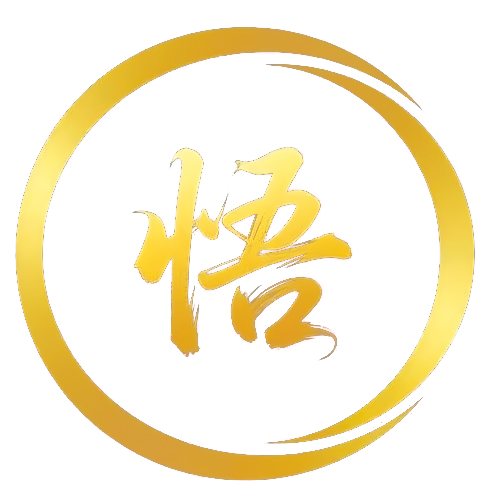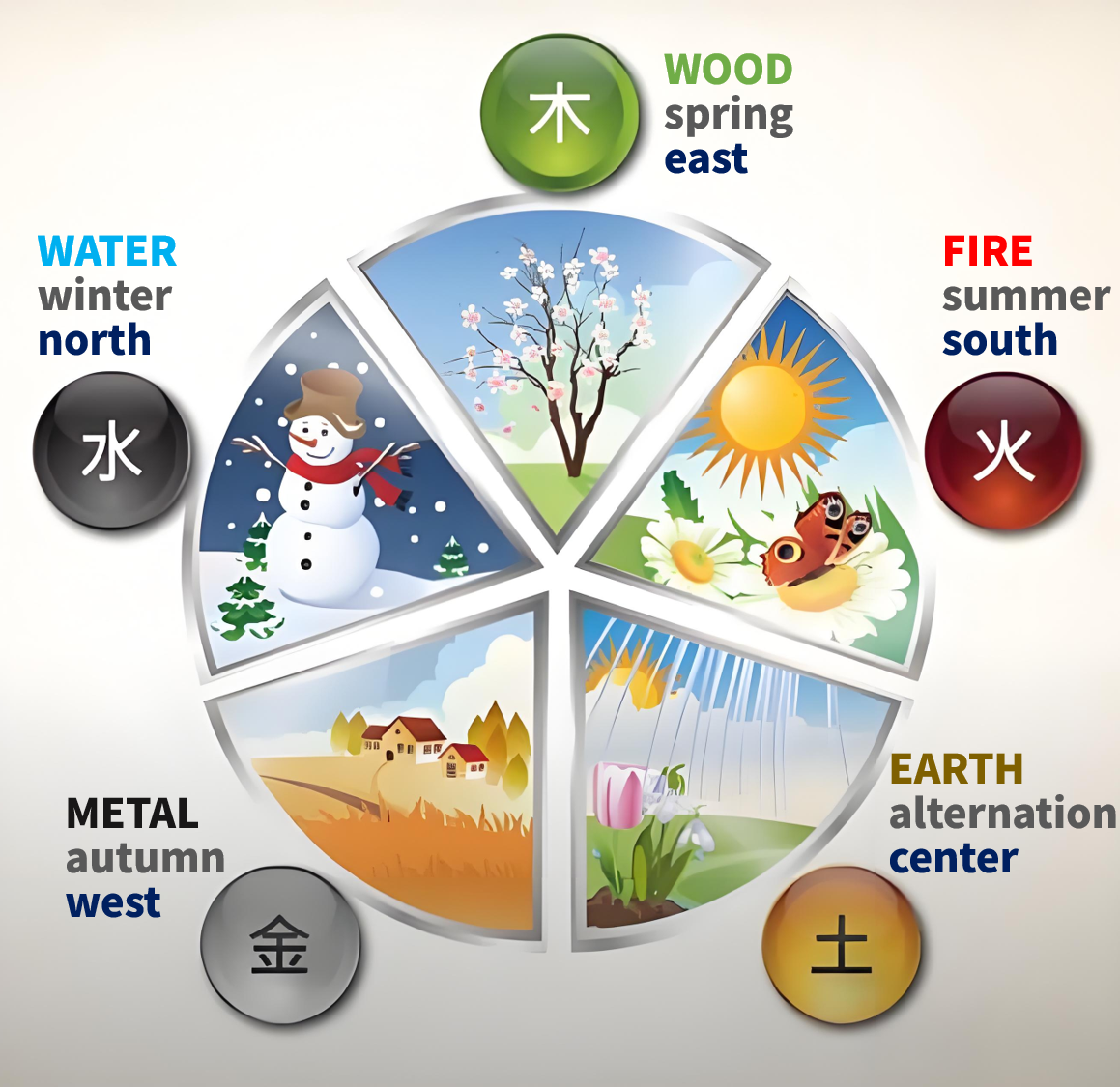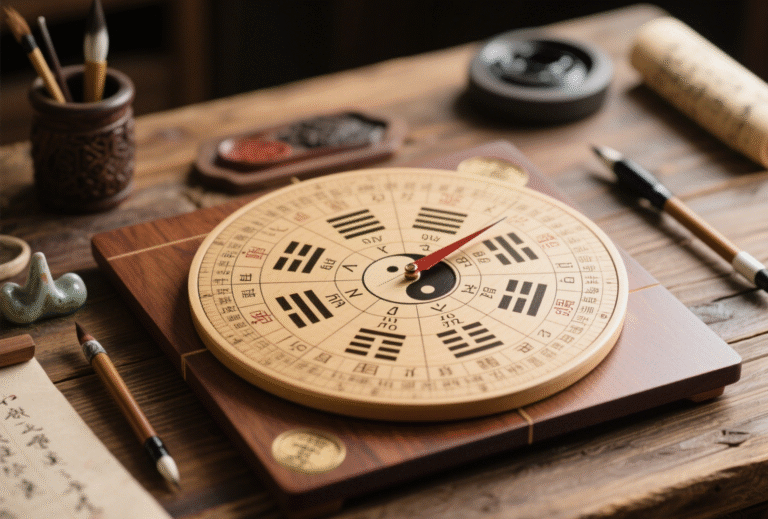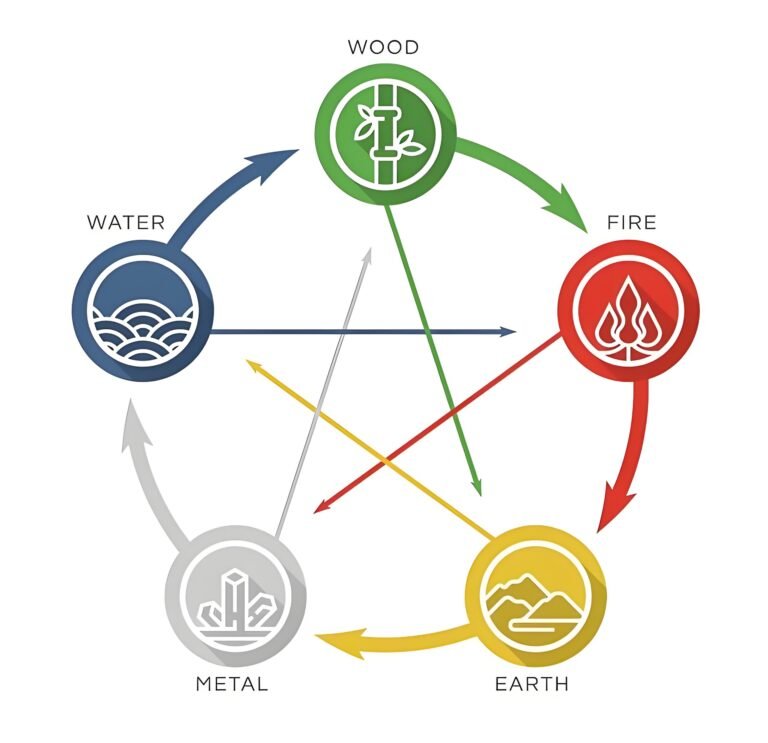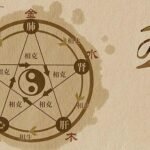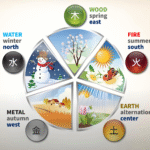In our previous article, we learned that the Five Elements (Wood, Fire, Earth, Metal, Water) represent five states of energy and how they maintain dynamic balance through “Nourishing” (Sheng) and “Controlling” (Ke) relationships. Now, let’s explore how these five energies connect to virtually everything. Ancient thinkers used Wu Xing to build a vast “network of correspondences,” linking seasons, directions, colors, the human body, and even personality traits into a unique language for understanding the world.

1. Wu Xing: Nature’s “Energy Tags”
Imagine the Five Elements as “energy labels” applied to natural phenomena:
- Seasons:
- Wood: Spring – The energy of rebirth, growth, and bursting vitality.
- Fire: Summer – The energy of heat, brightness, and peak flourishing.
- Earth: The Intersections of Seasons (especially Late Summer) – The stable, grounding, transformative energy at the core, connecting the seasons.
- Metal: Autumn – The energy of contraction, harvest, refinement, and settling down.
- Water: Winter – The energy of cold, stillness, storage, and rest.
- Directions:
- Wood: East – The direction of the rising sun, symbolizing new beginnings.
- Fire: South – The hottest, brightest direction.
- Earth: Center – The core, the point of balance.
- Metal: West – The direction of the setting sun, symbolizing completion and drawing in.
- Water: North – The coldest, darkest direction.
- Colors:
- Wood: Green/Blue-Green – The color of plants, representing life and growth.
- Fire: Red/Orange – The color of flame, representing passion and activity.
- Earth: Yellow/Brown – The color of soil, representing stability and nourishment.
- Metal: White/Gold/Silver – The sheen of metal, representing purity, clarity, and precision.
- Water: Black/Deep Blue – The color of deep water, representing depth, mystery, and potential.
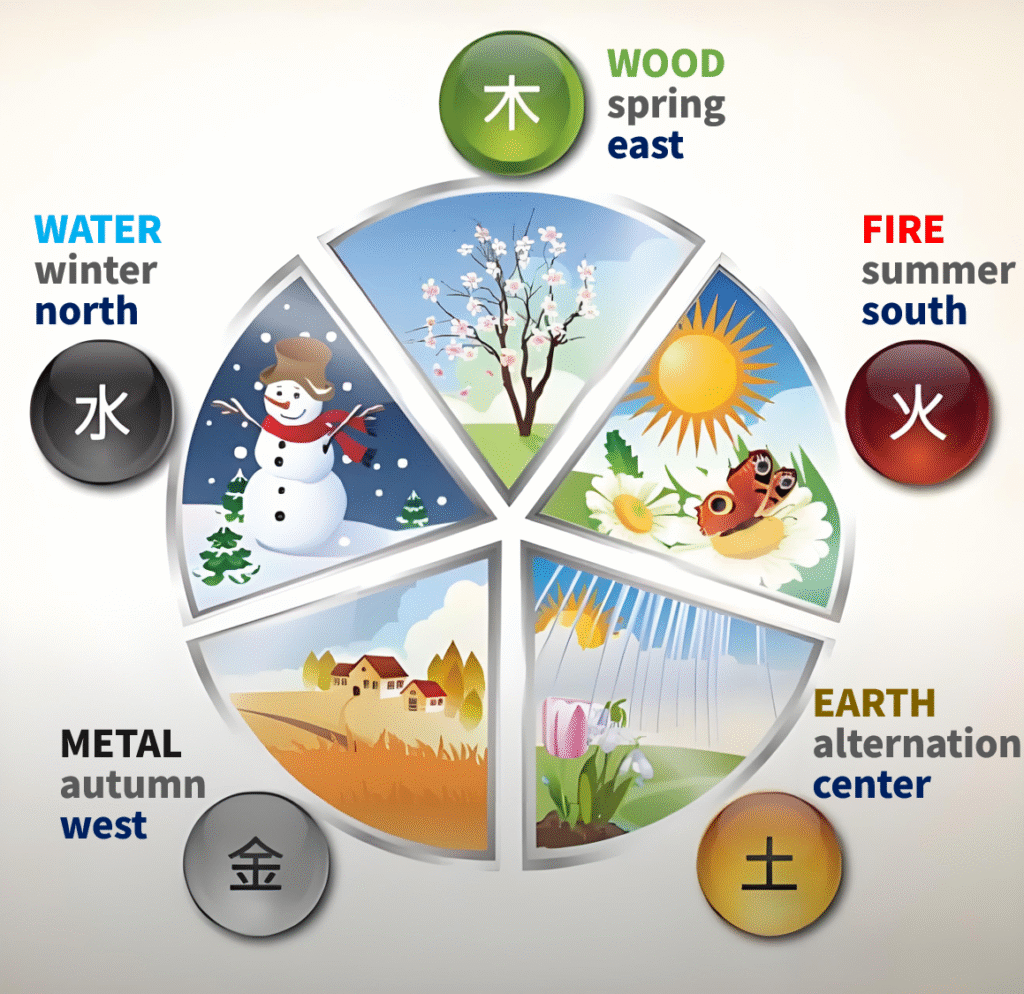
2. Wu Xing and Your Body
In Traditional Chinese Medicine (TCM), our internal organ systems are intimately connected to the Five Elements’ energies:
- Wood: Liver – Governs the smooth flow of Qi (vital energy) and emotions (like anger), similar to the free growth of branches.
- Fire: Heart – Governs blood circulation, warmth, and mental/spiritual activity (Shen), like the heat and light of fire. Associated with joy.
- Earth: Spleen (and Stomach) – Governs digestion, transformation of food into energy/nutrients, and thought processes. It’s the foundation, like fertile earth. Associated with overthinking/worry.
- Metal: Lungs – Governs respiration, taking in the new and letting go of the old, and the body’s defensive barrier (like metal’s protective nature). Associated with grief/sadness.
- Water: Kidneys – Governs fundamental life energy (Jing), water metabolism, willpower, and storage (like deep water). Associated with fear.

Important Note: This is a functional and energetic correspondence within the TCM framework, not a direct equivalent to Western anatomical organs. TCM believes excessive emotions can damage their corresponding organs (e.g., extreme anger harms the Liver, excessive joy can unsettle the Heart).
3. Nourishing & Controlling Cycles Revisited (Clarified)
Understanding how everything connects through Wu Xing hinges on the “Sheng” and “Ke” cycles:
- The Nourishing (Sheng) Cycle:
- Wood -> Fire: Wood burns to fuel Fire.
- Fire -> Earth: Fire burns down to ash, becoming Earth.
- Earth -> Metal: Earth contains and forms metal ores.
- Metal -> Water: Metal surfaces collect dew (ancient observation), or molten metal flows like water.
- Water -> Wood: Water provides moisture for trees to grow.
- Cycle: Wood -> Fire -> Earth -> Metal -> Water -> (back to Wood)
- “What Nourishes Me” & “What I Nourish”: From any element’s perspective (“Me”):
- “What Nourishes Me” (Mother): The element that provides my energy source (like a mother nourishing me).
- “What I Nourish” (Child): The element I support and expend energy to nurture (like my child).
- Example (Metal as “Me”):
- My Nourisher (Mother): Earth (Earth -> Metal)
- What I Nourish (Child): Water (Metal -> Water)
- The Controlling (Ke) Cycle:
- Wood -> Earth: Tree roots break up, hold, and absorb nutrients from soil.
- Earth -> Water: Earth (like a dam) absorbs and channels water, preventing floods.
- Water -> Fire: Water extinguishes fire.
- Fire -> Metal: Fire melts metal.
- Metal -> Wood: Metal tools (axes) cut down wood.
- Cycle: Wood -> Earth -> Water -> Fire -> Metal -> (back to Wood)
- “What I Control” & “What Controls Me”: From any element’s perspective (“Me”):
- “What I Control” (The Victorious): The element I have the power to manage, restrain, or overcome (like an opponent I can defeat).
- “What Controls Me” (The Victor): The element that has the power to manage, restrain, or overcome me (like an opponent who can defeat me).
- Example (Water as “Me”):
- What I Control (The Victorious): Fire (Water -> Fire)
- What Controls Me (The Victor): Earth (Earth -> Water)

The Crucial Point: Both cycles are essential! Nourishing alone leads to chaos and excess; Controlling alone leads to stagnation and suppression. Together, they create dynamic balance within any system – nature, the human body, or an individual’s life path. Imbalance (any element too strong or too weak) causes problems.
4. Wu Xing and Personality (Traditional View)
Traditionally, the Five Elements were also linked to personality traits, temperament, and even physical characteristics (Important: These are symbolic associations from traditional culture, not modern scientific personality types. The descriptions reflect historical perspectives and should be viewed with nuance):
- Wood (Governs Benevolence): Symbolizes growth and expansion. Traditionally, balanced Wood energy might suggest someone upright, kind, compassionate, and motivated. Imbalance could manifest as stubbornness, irritability, or indecisiveness.
- Fire (Governs Propriety): Symbolizes light and heat. Balanced Fire might suggest enthusiasm, sociability, respect for etiquette, and drive. Imbalance could manifest as impatience, quick temper, impulsiveness, or lack of energy.
- Earth (Governs Trustworthiness): Symbolizes nurturing and stability. Balanced Earth might suggest reliability, honesty, tolerance, and practicality (“walks the talk”). Imbalance could manifest as stubbornness, sluggishness, or unreliability.
- Metal (Governs Righteousness): Symbolizes structure and refinement. Balanced Metal might suggest decisiveness, integrity, a sense of justice, and orderliness. Imbalance could manifest as rigidity, coldness, harshness, or indecisiveness.
- Water (Governs Wisdom): Symbolizes flow and depth. Balanced Water might suggest intelligence, calmness, thoughtfulness, and adaptability. Imbalance could manifest as suspiciousness, inconsistency, lack of direction, or emotional detachment.
In Summary:
The Five Elements (Wood, Fire, Earth, Metal, Water) act like five “energy tags” and “relationship symbols” used by the ancients to connect and explain the changing seasons, directional qualities, color symbolism, the functions of our organs, and even aspects of human personality. Understanding Wu Xing means understanding how this ancient wisdom uses the cycles of Nourishing (Sheng) and Controlling (Ke) to depict a world where everything is interconnected in a state of dynamic balance. This system continues to be applied in fields like Chinese Medicine, Feng Shui, and destiny analysis, always centered on the pursuit of harmony and equilibrium.
Hope this deeper dive helps you explore the fascinating interconnected world of the Five Elements! What aspect of these connections do you find most intriguing?

